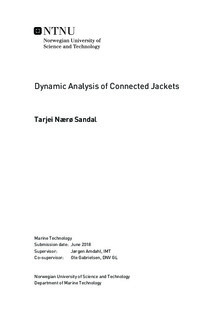Dynamic Analysis of Connected Jackets
Master thesis
Permanent lenke
http://hdl.handle.net/11250/2563978Utgivelsesdato
2018Metadata
Vis full innførselSamlinger
- Institutt for marin teknikk [3431]
Sammendrag
The dynamic behavior of jacket platforms connected by a bridge has been studied by time-domain simulations in USFOS, which is a nonlinear finite element program. The main motivation behind studying this, is to be able to do condition monitoring of connected jackets by assessing acceleration measurement. In order to do this, it is essential to gain an understanding of how the interaction between connected jackets may influence the acceleration measurements. The simulations have been done for a system consisting of two identical jackets, connected by a linear spring representing the bridge. The system has been subjected to waves from one direction only.
Initially, the simulations were done on a simplified model with jackets modelled as cylindrical cantilevered beams. The response was plotted in the frequency domain by running many simulations at different force frequencies. The phase lag of the force on the second jacket was kept constant by varying the distance between the jackets. Results from the simplified model were compared with results obtained in the specialization project. The hydrodynamic loads have been calculated by Morison's equations, and the nonlinear effects due to the wave load formulation have been studied.
A finite element model of two connected "real" jackets has been developed, and this model has been subjected to irregular waves. The response data from both static and dynamic analyses have been compared, to investigate to what extent the system is affected by dynamics. Additionally, it has been conducted a sensibility study on how the bridge stiffness influences the response values. The responses from the irregular waves were compared with respect to fatigue, extreme long term response and mean square response.
